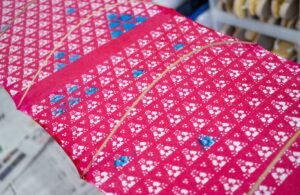12月3日3限授業にて、歴史文化学科・「伝統文化の現場」の授業の一つである、染め物実習にカメラマンとして参加しました。
外部講師の西大三先生のご指導の下、学生が染料を使用して布に色付けをしていきます。
今回は、反応染料という種類の染料を使用しました。反応染料は、化学反応により繊維の中に染着する種類の染料です。布の裏面から染料を入れることで、前もって施されていた模様が表側に鮮やかに浮かび上がる仕組みとなっています。近年では大量生産を前提として、染色機と呼ばれる機械を使った手法が主流になっていますが、着物を染める場合は今も手作業による染色が主流だそうです。今回学生が体験したように、伸ばした生地に刷毛で染料を塗り、人の手によって丁寧に染め上げていきます。
後半は、染料ではなく、顔料を使用した染物実習です。顔料は染料とは違い、水に溶けないという性質があります。学生は、カラフルな顔料とさまざまな形の型を使用して、白いハンカチにそれぞれ模様を作っていきます。


テンプル大学ジャパンキャンパスでは、これほど短時間で大掛かりな実習は未だに多くありません。特に国外からの学生が多いため、このような伝統文化に関する実習は、とても魅力的な体験だと思います。TUJ現学生会長のジェイソン・リー・ティールは、「このような日本の伝統文化を体験できる場を増やすべきだ」と言います。
On December 3rd, during 3rd period class, I participated as a photographer in a Japanese traditional dyeing practical class, one of the classes in the Department of History and Culture.
Under the guidance of Mr. Daizo Nishi, an outside lecturer, the students used dyes to color the cloth and made patterns.
In the first half, they used a reactive dye. The reactive dye is a type of dye that dyes into the fiber through a chemical reaction. By adding the dye from the back side of the cloth, the pattern, previously applied, appears vividly on the front side. In recent years, dyeing machines have become the mainstream method for mass production, but hand dyeing is still the mainstream method for dyeing kimonos. As the students experienced on that day, dye is applied to the stretched fabric with a brush and carefully dyed by hand.
The second half of the class is a dyeing practice using pigments instead of dyes. Unlike dyes, pigments are insoluble in water. Students will use colorful pigments and molds of various shapes to create their own patterns on white handkerchiefs.
At Temple University, Japan campus, there are still not many hands-on projects of this magnitude. TUJ’s current student president, Jason Lee Teal, says, “There should be more opportunities to experience traditional Japanese culture like this.”

文責:杉山 舜(TUJ)
